Brooding Temperatures for Small Poultry Flocks
PDF Version (282KB)
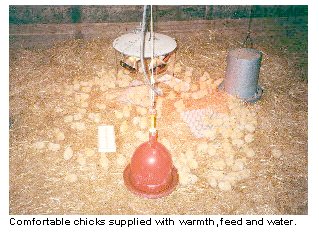
A hatched chick cannot maintain a proper body temperature without your help. Exposing a chick to cool temperatures in the first three weeks of life makes the bird uncomfortable and less likely to eat the feed and drink the water needed for a good start. In meat-type chickens, cool temperatures can lead to permanent heart damage. Exposing the young bird to cool (20ºC or 70ºF) for the first day or two on the farm can cause the bird to die from heart problems later. Heated premises are definitely needed for brooding.
For small flocks, the most common source of heat is a heat lamp. These lamps accommodate a 250-watt red or clear bulb. When suspended 45 to 60 cm (18 to 24") off the floor, they provide enough heat to brood up to 100 chicks for a single-light, or 300 to 500 for a four-light model. Some units have thermostatic controls, while others have to be raised or lowered to provide the required temperature at bird level. As the birds grow older, lower the temperature by raising the heat lamp or reducing the wattage of the bulbs.
Turn the heat on at least one day before the birds arrive on the farm. The temperature 1 cm (½ ") below the litter surface should be at least 26ºC (80ºF). Even if the air is the correct temperature, the birds can be chilled by the cold floor under them.
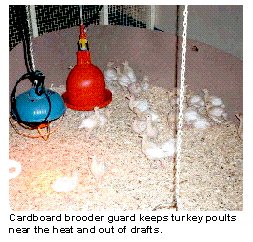
Temperature on the floor, at the edge of the heat source, should be 32 to 35°C (90 to 95°F) for the first week. As long as the temperature at the edge of the heat lamp or brooder stove is this warm, the air temperature 2m (6') away from the heat source can be as low as 28°C (82°F). The birds can then chose where they feel most comfortable. If you cannot maintain a hot point next to the heat lamp, an average air temperature of 30 to 31°C (85 to 88°F) is suggested. The temperature should be reduced by 3°C (5°F) per week, until the room temperature of 20ºC (70ºF) is reached. After six weeks of age, temperatures in the 18 to 21°C (65 to 70°F) range are desirable.
Some hatcheries will sell a 30 to 45cm (12 to 18") high corrugated cardboard that can be used to set up a brooder that forms a circle around the heat lamp. The ring helps protect the birds from drafts and piling in corners. For 300 birds, you might use a ring 3m (10') in diameter.
Judging Bird Comfort
The behavior and sounds of the chicks will indicate their comfort level. Comfortable birds will form a circle under the lamp, and make soft "cheeping" noises; cold birds will huddle and pile, and make sharp noises. If birds are too hot, they will crowd as far from the lamps as possible. Some birds will pant if the temperature is too high. Your birds will do a better job than a thermometer of telling you if they are comfortable. The diagrams below show how birds will move away or towards the heat lamp if they are hot or cold.
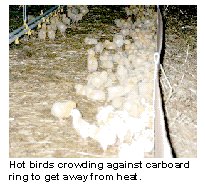
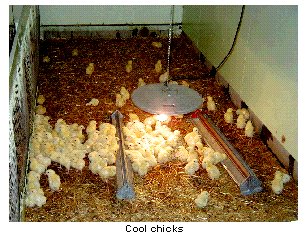
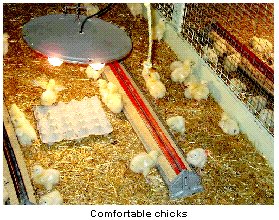
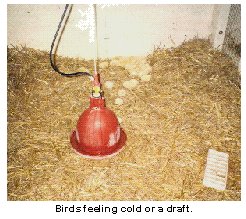
Warm Room Brooding
Some people heat their barns with space heaters or hot water pipes. Without a heat lamp or brooder stove to act as a hot point, the birds cannot move towards or away from the heat source to regulate their body temperature. As a result, it is more difficult to judge bird comfort when you warm room brood. Comfortable birds will be spread out and making full use of the pen. Cold birds will tend to bunch together, sometimes near the walls. Hot birds may also gather around cold, outside walls. Panting is a sign of heat stress.
